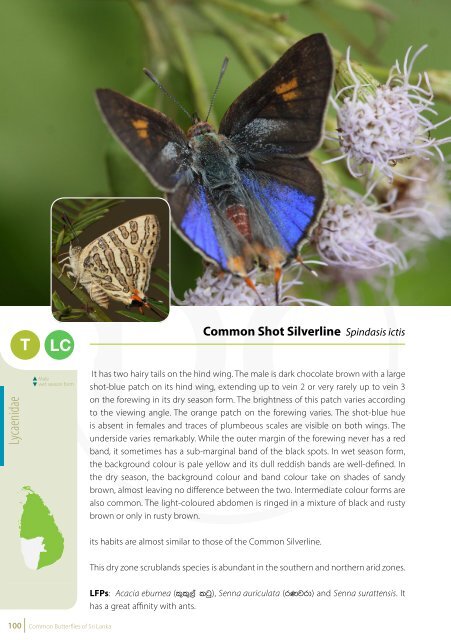Common Butterflies of Sri Lanka
Common Butterflies of Sri Lanka
Common Butterflies of Sri Lanka
Create successful ePaper yourself
Turn your PDF publications into a flip-book with our unique Google optimized e-Paper software.
T<br />
LC<br />
<strong>Common</strong> Shot Silverline Spindasis ictis<br />
Peacock Royal Tajuria cippus<br />
S<br />
LC<br />
Lycaenidae<br />
Male<br />
wet season form<br />
It has two hairy tails on the hind wing. The male is dark chocolate brown with a large<br />
shot-blue patch on its hind wing, extending up to vein 2 or very rarely up to vein 3<br />
on the forewing in its dry season form. The brightness <strong>of</strong> this patch varies according<br />
to the viewing angle. The orange patch on the forewing varies. The shot-blue hue<br />
is absent in females and traces <strong>of</strong> plumbeous scales are visible on both wings. The<br />
underside varies remarkably. While the outer margin <strong>of</strong> the forewing never has a red<br />
band, it sometimes has a sub-marginal band <strong>of</strong> the black spots. In wet season form,<br />
the background colour is pale yellow and its dull reddish bands are well-defined. In<br />
the dry season, the background colour and band colour take on shades <strong>of</strong> sandy<br />
brown, almost leaving no difference between the two. Intermediate colour forms are<br />
also common. The light-coloured abdomen is ringed in a mixture <strong>of</strong> black and rusty<br />
brown or only in rusty brown.<br />
its habits are almost similar to those <strong>of</strong> the <strong>Common</strong> Silverline.<br />
This dry zone scrublands species is abundant in the southern and northern arid zones.<br />
This is the only species <strong>of</strong> Royal with black eyes. The male has a shot-blue upper<br />
surface with a broad black apical band on the forewing. This black band extends along<br />
the outer and upper margin. The exterior margin <strong>of</strong> the blue patch on the forewing<br />
is irregular. The upper side <strong>of</strong> the female takes on a lighter shade <strong>of</strong> blue with a slight<br />
increase in brightness towards the forewing base. The exterior margin <strong>of</strong> its blue<br />
patch is regular. The blue on its hind wing does not reach the outer margin, leaving<br />
a black patch in between. It has a distal row <strong>of</strong> short, almost parallel, black lines. The<br />
underside looks similar in both sexes and is pure white with two black spots capped<br />
in orange near the tails. The light blue iridescence between these spots varies. Its<br />
distal band <strong>of</strong> black streaks is more prominent on the hind wing than on the forewing.<br />
The Peacock Royal readily comes to herbaceous flowers in open vegetation, but<br />
restricts itself to small trees in wooded areas. It usually selects high positions to bask.<br />
This butterfly can be found in any habitat where its larval food plants are available,<br />
except in dense forest areas. It is low in numbers in the hill country.<br />
Male<br />
Lycaenidae<br />
LFPs: Acacia eburnea (l=l=,a lgq), Senna auriculata (rKjrd) and Senna surattensis. It<br />
has a great affinity with ants.<br />
LFPs: Various Loranthaceae plants including Dendrophthoe ligulata, Taxilus cuneatus<br />
and Dendrophthoe falcata.<br />
100 <strong>Common</strong> <strong>Butterflies</strong> <strong>of</strong> <strong>Sri</strong> <strong>Lanka</strong><br />
<strong>Common</strong> <strong>Butterflies</strong> <strong>of</strong> <strong>Sri</strong> <strong>Lanka</strong> 101















